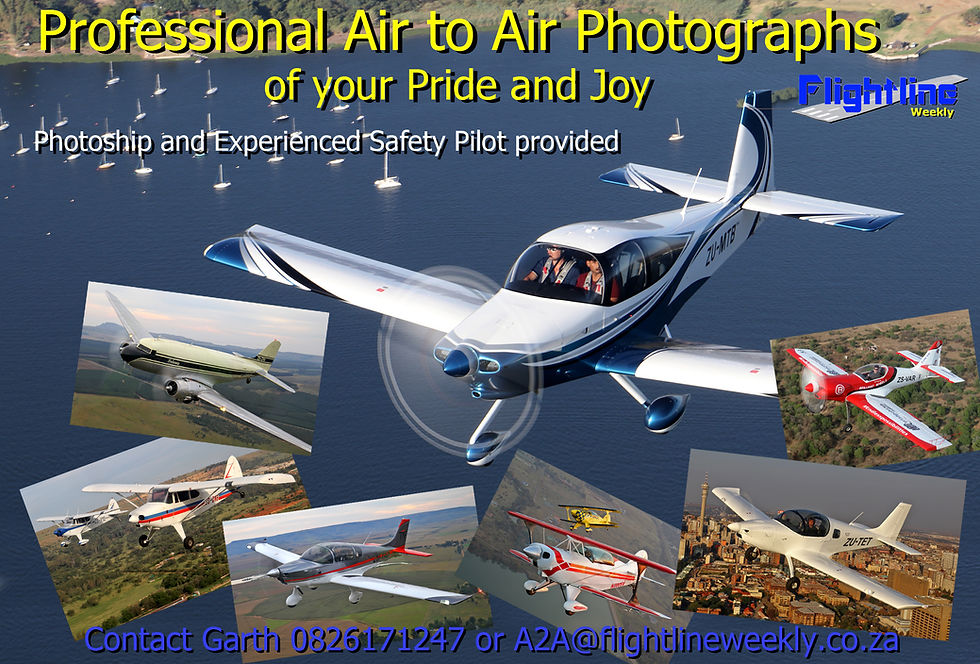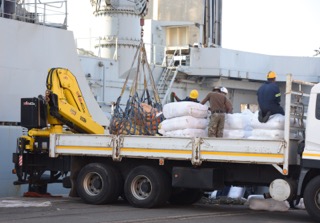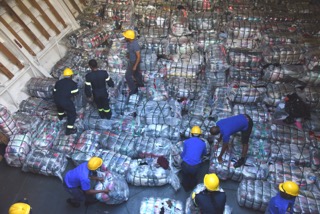News Letter 1 August 2019
- Garth Calitz
- Aug 1, 2019
- 9 min read
Good day all
As the warmer weather approaches the flying calendar suddenly seems to become more active with no less than three fly-ins planned for the inland region this weekend this in addition to the SAC KZN Reginal Aerobatics Championships.

SAC KZN Regionals will be held at Ladysmith Aerodrome on the 3 August and promises to be very entertaining, many of the top unlimited aerobatics pilots will be in action as well as the guys fighting out all the other classes.

The Lydenburg Fly-Inn Festival 2019 will be taking place at Lydenburg Airfield. Aircraft Static Displays, Spot Landing, Nav Rally, Food and Craft Stalls and RC Aircraft have been planned for the weekend. A Spit Braai and live Music will be provided for all the visitors that decided to camp under the wing. All in all, it seems like it will be one to remember.


The EAA will be visiting Rustenburg Airfield for one of their fantastic Fly-in breakfasts. Rustenburg’s Fly-in breakfast are becoming very popular with over 100 aircraft attending the last one they hosted. Everyone is welcome to join.

Thabazimbi Fly-Inn will be taking place this weekend to coincide with the Thabazimbi Carnival, Fly-in for the day and experience a flight past the majestic Waterberg Mountains. Free shuttle between the airfield and the carnival will be provided.


Response from the SACAA on challenges plaguing their smooth operation.

In an attempt to clear up the speculation regarding the difficulties at the SACAA, I approached Ms Poppy Khoza for answers on some of the pertinent issues. An email was sent to Ms Khoza (10 July 2019), I received a reply within 30 minutes informing me that my queries had been forwarded to her communications team. Later that same day I received a call from Mr Kalebo Ledwaba asking me to give him time to gather the answers and he undertook to provide answers by close of business on Monday 15 July 2019. The promised date arrived and passed without any answers.
On Wednesday 17 July I sent an email to Mr Ledwaba, on the morning of 18 July I received a call from Mr Ledwaba in which he stated he was waiting for some of the information from different departments, as my queries included many departments. He promised to have relay the required detail to me by close of business the following Tuesday (23 July 2019) once again there was no reply on the date. On 25 July I sent an email once again requesting the information, two days later I was contacted telephonically by Mr Pappie Maja (External Communication Expert) who promised to have an answer to my request by Tuesday 30 July 2019, 20 days after the initial request. I received answers to some of my queries at 18:30 on Tuesday evening.
CAA responses are in red.
- I was informed confidentially be a member of the SACAA that you server was infected by “ransomware” and that all users were locked out pending the payment of a ransom, is there any truth in this?
The matter is currently being investigated by law enforcement agencies. It is important that we allow them the space, independence, and time to do their work thoroughly and without any form of interference. Moreover, and for obvious reasons, discussing security matters publicly is not prudent. We have restored all our ICT services, and our focus at this point is to provide prompt service to our clients and eliminate any backlog.
- Many of the pilots in my social circle are at wits end due to the backlog of ATF issuing, some are reporting that it is well beyond 500 individual ATF’s. Can you please inform us of the correct number of ATF’s currently outstanding?
From the 1st of April to date, the SACAA received 341 ATF’s and 53 ATF’s that was not issued within 2 to 10 days. It is worth noting that the application form clearly indicates that a processing time is 20 days. The backlogs were all due to missing information in the applications.
- It has been said that the ELT register was last updated in 1988, Can you please offer some clarity on this situation?
The ELT database is updated as and when an ELT is registered with the SACAA. It is totally dependent on applications received from industry. This happens on a daily and weekly basis.
- A fully qualified commercial pilot recently had to forfeit a contract flying position in Central Africa due to the delay on renewing his license, he had to inform the company concerned that he could not report at the specified time as he had waited over two months for his license. Please can you clarify how long a PPL, CPL and ATP renewal should take and how long the current backlog is? Previously (before the digital system was adopted) this process took no more than a few hours.
The turnaround time for any of the licenses is 5 working days for walk-in; 7 working days for courier or mail applications. If a license is not issued within this time, there must have been a reason and this would have been communicated to the client as to the cause of the delay and since we are not aware which client you are referring to, we are not able to give you a comprehensive response.
- Recreational Aviation were promised that the reintegration RAASA into the SACAA would be a seamless process, this move seems to be the origin of the current problems as waiting periods for all documentation severely increased as from the date of integration. Can you please comment on this?
The standardization of the process contributed to the delays at the beginning however the organisation decided to waive these to ensure that the client does not suffer.
We sincerely hope the worst of the challenges at the CAA are now under control and that services will be brought to the level that will not hinder the growth of the aviation in future.

The SANDF will provide Humanitarian Assistance to Mozambique

When Cyclone Idai hit the shores of Mozambique, Zimbabwe and Malawi on Thursday evening, 21 March 2019, it destroyed everything in its wake. It is said that it was the deadliest tropical cyclone in the South-West Indian Ocean. Beira, which is one of Mozambique's largest cities, was one of the worst affected areas. The SA Air Force (SAAF) helicopters were requested to be part of the rescue operation. They did a tremendous job and helped with the rescue of 167 people and reunited several families.


The UN Secretary-General, Antonio Guterres urged International donors to assist, as these countries will not be able to recover on their own. South Africa gave R135 million to the governments of Mozambique, Zimbabwe and Malawi to help rescue and rebuilding operations after Cyclone Idai in March.
Four months after Cyclone Idai, the South African Revenue Service (SARS) with the assistance of the SA Navy, is once again offering their assistance to Mozambique (Beira) with more donations. The SAS DRAKENSBERG has been loaded with tons of donations packs since Saturday, 27 July 2019 at the shores of Naval Base Durban, to undertake the humanitarian assistance mission in Mozambique.
On completion of the loading, the SA Navy Support Vessel will turn its propellers to Beira on Thursday, 1 August 2019, for the first offload of these donations, aimed at assisting the victims of floods. According to the Officer Commanding SAS DRAKENSBERG, Capt (SAN) Mabula, the operation will be performed more than once due to the number of donations that still needs to be transported to Beira.
Chief of Joint Operations, Lt Gen Barney Hlatshwayo wishes the soldiers a safe journey. He said that “our soldiers are doing an excellent job and I am proud of them”. He expressed his solidarity with the people of Mozambique and said “our thoughts and prayers are with all of those who have lost loved ones and their livelihoods. We as soldiers of the South African National Defence Force (SANDF) stand ready to assist the people of Mozambique so that they can rebuild their lives after this natural disaster”.

Hawaii a Proving Ground for Electric Aviation Challenge

Electric aviation start-up Ampaire and Mokulele Airlines plan to operate regular hybrid-electric test flights in Hawaii by the end of 2019. Flights servicing islands are an attractive target for early electrification, given their short-haul routes.

With that in mind, Hawthorne, California-based electric aviation start-up Ampaire, Inc. plans to demonstrate a retrofitted hybrid-electric plane on a commercial route on the Hawaiian island of Maui later this year.


In partnership with Mokulele Airlines, and with backing from the Elemental Excelerator, a Honolulu-based non-profit start-up accelerator, Ampaire plans to launch regular test flights between airports in Kahului and Hana, Maui.
For now, Ampaire is focused on hybrid-electric flight. The company’s Electric EEL is a twin-engine Cessna 337 Skymaster retrofitted to include one conventional combustion engine and one Ampaire electric motor. The plane will have a range of about 200 miles, with reserves, according to Ampaire product manager Brice Nzeukou. “We see the most practical step to bring the compelling benefits of electric aviation — lower operating costs, lower maintenance costs — to the market by starting with hybrid-electric first versus going full electric,” Nzeukou told said.

Ampaire conducted its first public test flight above Camarillo, California on June 6. According to Nzeukou, the prototype Electric EEL performed as expected during its initial test flights. “We’ve learned that the aircraft is able to recover safely. Our design targets have been validated. That’s been one of the major takeaways: The safety of the aircraft is exactly what we thought it would be,” he said. Ampaire expects to receive a supplemental type certificate (STC) from the Federal Aviation Administration for the Electric EEL by the end of 2021.
Elemental Excelerator selected Ampaire as one of its portfolio companies, which receive up to $1 million in funding, in its 2019 cohort. For the team at Elemental Excelerator, Ampaire’s Electric EEL was the right plane at the right time for Hawaii. “We targeted electric aircraft companies in our last round because our analysis indicated it was the right time for the market,” Ramsay Siegal, managing director of Elemental Excelerator, stated.

“With the expectation that regulatory frameworks governing electric air travel will come into focus globally, we wanted to support a near-term solution to satisfy flight-time requirements, charging infrastructure, and other commercialization elements so they are ready to scale the moment the FAA landscape enables them to do so,” she said.
The fact that Ampaire aims for the Electric EEL to be FAA-certified by 2021 was a deciding factor in Elemental Excelerator’s support. “We were specifically excited about Ampaire because of their approach of retrofitting existing airplanes, rather than building an entirely new electric aircraft that could be years away. Ampaire's partnership with Mokulele Airlines is going to help make commercial electric flights a reality far faster than many people think,” said Siegal.
Siegal went on, “Electrifying the aviation industry can put a massive dent in global carbon emissions, but it's an extremely thorny problem. And it's especially pressing in Hawaii, where the aviation sector accounts for nearly one-third of petroleum usage.”

Elemental Excelerator is helping to fund the entire Maui demonstration, said Ampaire’s Nzeukou, from material purchases to operating costs. “Without their funding, this project would have never happened,” he said.
Nzeukou said Ampaire is committed to transitioning to all-electric planes over time. The company views all-electric flight as a technology maturation issue. With billions of dollars being invested in battery technology globally, he said, “We’re hoping to see the fruits of those investments realized: higher energy density, different chemistries coming out and production costs going down.”

“As soon as it is practical and compelling and really viable for our business case and for our customers, that’s when we would consider doing an all-electric version." The company sees its Electric EEL, the retrofitted Cessna 337 Skymaster, as a first step in a process that culminates in Ampaire selling planes designed to be all-electric from the start. The next step, according to Ampaire’s CEO Kevin Noertker, is likely the development of either a hybrid-electric or all-electric nine- to 19-passenger commuter or cargo aircraft.
“We want to sell our planes under the Ampaire brand,” Nzeukou said. “Our primary focus, and our main strategy, is to be an original aircraft manufacturer, and to retrofit planes for the time being and eventually go into new-build, clean-sheet aircraft. However,” he went on, “there are opportunities to license our technology to other aircraft OEMs that may want to be able to offer the benefits of electric propulsion to their customers.”

Last week, Ampaire began accepting letters of intent for the Electric EEL from general aviation pilots. The two versions of the plane will seat four or six passengers and be outfitted with a 215-horsepower (hp), 160-kilowatt electric motor and either a Continental IO-550 310-hp piston engine or a Continental CD-300 Jet A diesel 300-hp engine. According to Ampaire, either version “will be cost-competitive with comparable current production piston twins.”
Ampaire is among the startups jostling to be first to bring hybrid-electric or all-electric planes to market. GTM reported in April that British Columbia’s Harbour Air is partnering with electric propulsion start-up magniX to retrofit its entire 40-strong fleet of conventional seaplanes into an all-electric fleet.
























